| 15 March |
• yesterday • tomorrow |
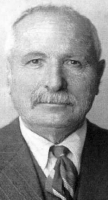
Artémides
One of three sons born to Albino Vecchi and Luigi Zatti. His was a poor family, and the boy had to drop out of school at age nine to work for a wealthy neighbor. The family eventually immigrated to Bahia Blanca, Argentina to find work, arriving in Buenos Aires on 9 February 1897. There Artemide worked in a tile factory, and attended a local parochial school run by the Salesians. He felt drawn to the Salesians, and at age 20 entered their seminary, Casa di Bernal.
Artemide contracted tuberculosis while caring for a young Salesian priest with the disease, a man who died from it in 1902. He was sent to San Josè Hospital for what little treatment there was in that day, but with little hope. With his friend and unofficial doctor, Father Evarisio Garrone, Artemide prayed for the intervention of Our Lady, Help of Christians, offering to dedicate his life to the care of the sick; the young Salesian was miraculously and completely healed.
He kept his promise. He worked in the San Jose pharmacy, and learned about hospital management from Father Garrone. Upon his mentor's death, Artemide took charge of the hospital, and what time he could spare from his administrative duty was spent caring for patients. Today the hospital is named in his honour.
12 October 1880 at Boretto, Reggio Emilia, in northern Italy
• 15 March 1951 of cancer at Bahia Blanca, Argentina
• relics interred in the Salesian chapel at Viedma, Argentina
• 9 October 2022 by Pope Francis
• the canonization miracle involved the 24 August 2016 healing of a man in Tanauan Batangas, Lipa, Philippines who had suffered a “right cerebellar ischemic stroke, complicated by massive hemorrhagic lesion”, and was in such bad shape that medical authorities sent him home so he could die with family
Artemide Zatti, Salesian religious brother, left the diocese of Reggio Emilia with his family to seek a better life in Argentina, the land dreamt of by Don Bosco. There he discovered his Salesian vocation, which took the form of a passionate, competent and loving service to the sick. His almost fifty years in Viedma represent the history of an exemplary religious, careful to accomplish his duties in his community and totally devoted to the service of those in need. May his example help us to be conscious of the presence of the Lord and bring us to welcome him in all our needy brothers and sisters. – from the beatification homily by Pope John Paul II
https://catholicsaints.info/blessed-artemide-zatti/
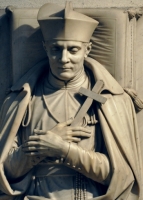
• Apostle of Vienna
• Clemens Mary Hofbauer
• Johannes Hofbauer
• John Dvorák
• Klemens Maria
• Second Founder of the Redemptorists
Ninth child of a butcher who changed the family name from the Moravian Dvorák to the Germanic Hofbauer. His father died when Clement was six years old. The young man felt a call to the priesthood, but his family was too poor to afford his education. Apprentice and journeyman baker at Premonstratensian monastery at Bruck, Germany. Hermit.
When hermitages were abolished by Emperor Joseph II, Clement worked as a baker in Vienna, Austria. Hermit in Italy with Peter Kunzmann, taking the name Clement. Made three pilgrimages to Rome. During the third, he joined the Redemptorists at San Giuliano, adding the name Marie. He met some sponsors following a Mass, and they agreed to pay for his education. Studied at the University of Vienna, and at Rome. Ordained in 1785, and assigned to Vienna.
Missionary to Warsaw, Poland with several companions from 1786 to 1808, working with the poor, building schools and orphanages; the brothers preached five sermons a day. Spiritual teacher of Venerable Joseph Passerat. With Father Thaddeus Hubl, he introduced the Congregation of the Most Holy Redeemer to Poland. From there he sent Redemptorist missionaries to Germany and Switzerland. Clement and his companions were imprisoned in 1808 when Napoleon suppressed religious orders, then expelled to Austria.
Noted preacher and spiritual director in Vienna. Chaplain and spiritual director of an Ursuline convent. Founded a Catholic college in Vienna. Worked with young men, and helped revitalize German religious life. Worked against the establishment of a German national Church. Worked against Josephinism which sought secular control of the Church and clergy.
26 December 1751 at Tasswitz, Moravia (in the modern Czech Republic) as John Dvorák
15 March 1820 at Vienna, Austria of natural causes
20 May 1909 by Pope Pius X
Vienna, Austria (named by Pope Saint Pius X in 1914)
Religion in Austria has lost its chief support. - Pope Pius VII on hearing of Saint Clement's death
https://catholicsaints.info/saint-clement-mary-hofbauer/

• John Balicki
• Giovanni Balicki
Born to a poor but pious family. Attended twelve years of school in Rzeszow, Poland with teachers who taught a love of Polish culture. Entered the seminary at Przemysl, Poland in September 1888. Ordained on 20 July 1892. Assistant pastor of Polna, Poland where he was noted as a gifted preacher and man of prayer. Studied at the Pontifical Gregorian University from 1893 to 1897, concentrating on Saint Thomas Aquinas, spending his evenings in prayer, his free time visiting the shrines of the saints. He came to believe that science could also lead a man to God.
Professor of dogmatic theology at the seminary in Przemysl in 1897. Prefect of studies for three years. Reluctant vice-rector of the seminary in 1927; rector in 1928. He considered the spiritual formation of priests his most important mission, studying reports carefully, and praying for help before presenting candidates to the bishop. Spiritual director of Blessed Ladislaus Findysz.
In 1934 his failing health forced him to resign from the seminary posts, but he lived at the seminary, hearing confessions and working as a favourite spiritual director to students. In 1939 when Przemysl was divided between the warring German and Soviet forces, Father Jan stayed in the Soviet sector, hoping to keep the seminary running; soon, however, he was forced to move from the seminary to the bishop's residence where he stayed even after the war. In his last years his health failed more and more as his tuberculosis spread. Jan was noted for his gentle discernment of the people who entered his confessional, and his devotion to prayer as a way to know the heart of God.
Father Jan wrote a study of mystical prayer that listed four degrees:
• prayer of quiet
• prayer of simple union
• ecstatic union
• perfect union
He gave a list of the seven steps for progress in the spiritual life -
• serious approach to life
• readiness to be critical of self
• unshakable confidence in prayer
• joy of spirit
• love for suffering
• praise of divine mercy
• continuous self amendment
25 January 1869 in Staromiescie, Poland
15 March 1948 of pneumonia and tuberculosis in Przemysl, Poland
18 August 2002 by Pope John Paul II at Krakow, Poland
https://catholicsaints.info/blessed-jan-adalbert-balicki/
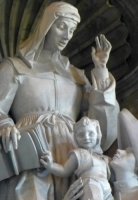
• Louise de Marillac Le Gras
• Luisa
Though she considered a religious vocation from an early age, her ill health kept any house from taking her. She married Antony LeGras, an official to the queen, in 1611. Widowed in 1625. Spiritual student of Saint Vincent de Paul. With Saint Vincent, she founded the Daughters of Charity in 1642, receiving Vatican approval in 1655. Founded the Sisters of Charity, took her vows in the order, and served as its superior until her death. Spiritual guide for groups of lay women.
12 August 1591 at Meux, France
• 15 March 1660 at Paris, France of natural causes
• body incorrupt
11 March 1934 by Pope Pius XI
• disappointing children
• loss of parents
• people rejected by religious orders
• sick people
• social workers (proclaimed on 12 February 1960 by Pope John XXIII)
• Vincentian Service Corps
• widows
Be diligent in serving the poor. Love the poor, honour them, my children, as you would honor Christ Himself. - Saint Louise
https://catholicsaints.info/saint-louise-de-marillac/
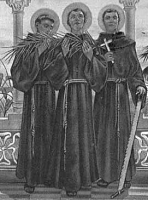
• Francesco de Fermo
• Francis of Petrioli
• Frans av Fermo
One of three Franciscans assigned to Armenia with a mission to improve the conditions of Christians there, and to bring the faith to any Muslims who were open. In Arzenga, Armenia, on the first Friday in Lent, the group stood in the street and preached Jesus to the people going to prayers. To prevent violence in the street, the local leader ordered a stop to the preaching. The missionaries ignored the order and returned the following Friday. Local Muslims threatened to kill the street preachers, and the council of elders agreed. On the third Friday, the missionaries returned, were arrested, and dragged to the city's public square. A local Muslim man tried to defend them and spoke against violence, but he was killed on the spot. The mob then turned on the Franciscans, attacking with swords, dismembering the men before finally killing them. Martyr.
• beheaded on 15 March 1314 at Arzenga, Armenia
• their severed arms and legs were hung on the city walls as a warning, their bodies dragged to the fields to be left for wild animals
• body parts collected and buried by a local priest and his parishioners
https://catholicsaints.info/blessed-francis-of-fermo/

Monaldo
28 April (translation of relics)
One of three Franciscans assigned to Armenia with a mission to improve the conditions of Christians there, and to bring the faith to any Muslims who were open. In Arzenga, Armenia, on the first Friday in Lent, the group stood in the street and preached Jesus to the people going to prayers. To prevent violence in the street, the local leader ordered a stop to the preaching. The missionaries ignored the order and returned the following Friday. Local Muslims threatened to kill the street preachers, and the council of elders agreed. On the third Friday, the missionaries returned, were arrested, and dragged to the city's public square. A local Muslim man tried to defend them and spoke against violence, but he was killed on the spot. The mob then turned on the Franciscans, attacking with swords, dismembering the men before finally killing them. Martyr.
• beheaded on 15 March 1314 at Arzenga, Armenia
• their severed arms and legs were hung on the city walls as a warning, their bodies dragged to the fields to be left for wild animals
• body parts collected and buried by a local priest and his parishioners
https://catholicsaints.info/blessed-monaldus-of-ancona/
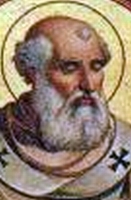
Zacharias
Son of Polichronius, but little else is known of his early life. Deacon. Advisor to Pope Gregory III. 91st pope. First pope after Saint Gregory the Great to not seek imperial confirmation on his election. Negotiated peace between the Lombards and Greek empire. Restored the Lateran palace and many churches around Rome. Encourged the missionary work of Saint Boniface, and appointed Saint Abel as archbishop of Rheims, France. When Venetian slavers bought slaves at Rome to sell to Saracens in Africa, Zachary bought them all so that Christians should not become the property of heathens. Translated the Dialogues of Gregory the Great into Greek. Many of his actions among the royal powers of the day continued to echo for centuries.
• at Calabria, Italy
• Greek ancestry
5 December 741
• 22 March 752 of natural causes
• buried at Saint Peter's Basilica, Rome, Italy
• making peace with King Luitprand
• with a dove and olive branch over him representing peace
https://catholicsaints.info/pope-saint-zachary/

• Anthony Cantoni
• Antonio...
One of three Franciscans assigned to Armenia with a mission to improve the conditions of Christians there, and to bring the faith to any Muslims who were open. In Arzenga, Armenia, on the first Friday in Lent, the group stood in the street and preached Jesus to the people going to prayers. To prevent violence in the street, the local leader ordered a stop to the preaching. The missionaries ignored the order and returned the following Friday. Local Muslims threatened to kill the street preachers, and the council of elders agreed. On the third Friday, the missionaries returned, were arrested, and dragged to the city's public square. A local Muslim man tried to defend them and spoke against violence, but he was killed on the spot. The mob then turned on the Franciscans, attacking with swords, dismembering the men before finally killing them. Martyr.
• beheaded on 15 March 1314 at Arzenga, Armenia
• their severed arms and legs were hung on the city walls as a warning, their bodies dragged to the fields to be left for wild animals
• body parts collected and buried by a local priest and his parishioners
https://catholicsaints.info/blessed-anthony-of-milan/
• 29 October as one of the Martyrs of Douai
• 1 December as one of the Martyrs of Oxford University
Raised Protestant. Educated at Lincoln College, Oxford. Convert to Catholicism. Studied for the priesthood at Douai, Rheims, and Rome, Italy. Ordained in 1581, he returned to England to minister to covert Catholics. Betrayed by an apostate in the house of Saint Margaret Clitherow. Martyr.
1558 at Wells, England
martyred on 15 March 1583 at York, North Yorkshire, England
29 December 1886 by Pope Leo XIII (cultus confirmed)
The joy of this life is nothing; the joy of the after life is everlasting. - Blessed William Hart
https://catholicsaints.info/blessed-william-hart/

• Aghios, Arwystli, Aristibule
• Aristobulus Senex
• Aristibulus the Old
• Apostle to Britain
• 4 January (feast of the Seventy Disciples)
• 31 October (feast of the assistants of Saint Andrew)
• 16 March (Eastern Orthodox calendar)
One of the 70 disciples sent out to preach Christianity at the beginning of the Church. Missionary to the British Isles. Mentioned by Saint Paul the Apostle in the Epistle to the Romans ("Greet those who are of the household of Aristobulus."). Martyr.
https://catholicsaints.info/saint-aristobulus-of-britannia/
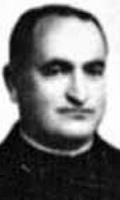
Baptized at the age of one day. Member of the Salesians of Don Bosco, beginning his novitiate in Sarrià-Barcelona, Spain, and making his profession on 3 February 1906. Priest. Worked in colleges in the Spanish cities of Sarrià, Madrid, Valencia, Béjar, Salamanca and Santander. Martyred in the Spanish Civil War.
4 January 1887 in Portela-Allariz, Orense, Spain
15 March 1937 in Madrid, Spain
28 October 2007 by Pope John Paul II
https://catholicsaints.info/blessed-pio-conde-y-conde/

• Menignus the Dyer
• Menigno of Pario
Married layman who worked as a fuller and cloth dyer. Tortured, his fingers hacked off, and executed in the persecutions of Decius for tearing down an edict suppressing the faith. Martyr.
• beheaded c.250 in the Greek city of Parium in the Hellespont (in modern Turkey)
• witnesses say they saw his soul leave the mouth of his severed head in the form of a dove
https://catholicsaints.info/saint-menignus-of-parium/
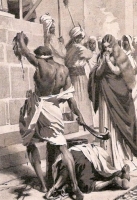
Lucretia, Leocrizia, Lucrezia
Born to wealthy Moorish parents, Leocritia converted to Christianity; her family drove her out. Saint Eulogius of Cordoba gave her shelter. She entered into religious life, was arrested, scourged, and martyred.
Cordoba, Spain
beheaded on 9 March 859 in Cordoba, Spain
https://catholicsaints.info/saint-leocritia-of-cordoba/
Nicander the Physician
Physician noted for his charity, for ministering to and treating people imprisoned for their faith, and giving Christian burial to martyrs who died in the persecutions of Diocletian. Imprisoned, tortured and martyred for his faith and good works.
Egyptian
beheaded in the 4th century in Alexandria, Egypt
https://catholicsaints.info/saint-nicander-of-alexandria/
Premonstratensian canon in Vicogne, France. Abbot of the house in 1212. During his 17 year abbacy he was known for re-invigorating the spiritual lives of his brothers, re-building and expanding the monastery, and collecting the relics of saints.
late 12th century
• 26 September 1229 of natural causes
• interred in the choir of his abbey
https://catholicsaints.info/blessed-walter-of-quesnoy/
Arnaldo
Studied law in Toulouse, France. Augustinian hermit, taking his vows on 11 July 1494; known for his strict observance of the Rule of his Order.
20 May 1507 of natural causes
never officially beatified, but popular devotion began soon after his death
https://catholicsaints.info/blessed-arnold-of-siena/
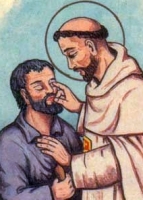
Mercedarian monk at the convent of Santa Eulalia in Seville, Spain. Miracle worker restoring sight to the blind, hearing to the deaf, and raising the dead to life. Died during a vision of the Blessed Virgin Mary.
https://catholicsaints.info/blessed-ludovico-de-la-pena/
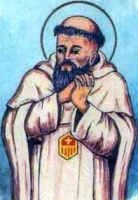
Mercedarian friar, receiving the habit from Saint Peter Nolasco. First Commander of the San Martino monastery in Perpignan, France. Miracle worker.
https://catholicsaints.info/blessed-peter-pasquale/
Christian slave bought in Rome, Italy by Jewish traders and taken to Evora, Portugal where he was martyred by his new owners.
5th century Rome, Italy
5th century Evora, Portugal
https://catholicsaints.info/saint-mancius-of-evora/
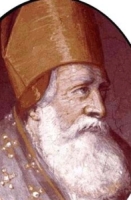
• Eusebio II
• Eusebius II of Vercelli
Bishop of Vercelli, Italy in 501.
c.520
https://catholicsaints.info/saint-eusebius-ii/
Wealthy land owner at Campania, Italy. He and his brother Gregory became monks, taking the cowl from Saint Benedict at Monte Cassino. Monk at Terracina.
c.555 at Capua, Italy of natural causes
https://catholicsaints.info/saint-speciosus/
Sisebut, Sisebutus
Monk. Abbot of the Spanish monastery of Cardena.
1086 near Burgos, Castile, Spain of natural causes
https://catholicsaints.info/saint-sisebuto/
Bodianus, Bozian
I can find no information on this saint.
6th century Wales
https://catholicsaints.info/saint-bodian-of-hanvec/
Son of Saran of Cloncullen. Monk.
County Tipperary, Ireland
https://catholicsaints.info/saint-eoghan-of-concullen/
Listed in several Irish martyrologies, but no details about them have survived.
https://catholicsaints.info/three-daughters-of-eltin/
Nun. Martyr.
424 in Coria, Hispania Lusitana (in modern Portugal)
https://catholicsaints.info/saint-vicenta-of-coria/
Nun in Capua, Italy.
https://catholicsaints.info/saint-matrona-of-capua/
CatholicSaints.Info Portable Edition